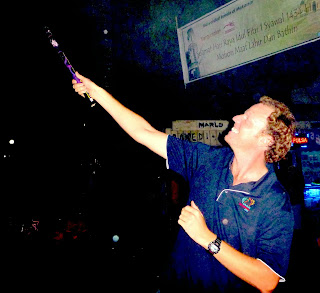- Everything must be amplified and once it is amplified, must be at full volume. There is no such thing as too loud, if it is not distorting it should be turned up.
- In Indonesia, people think the radio will travel further when they shout into it. This also goes for microphones.
- Cassava can be in any food, be it sweet, savoury or other. If you are not sure what you are eating, it is probably cassava. It is the favourite lengthener to any dish or dish in its own right.
- There is no such thing as too much sugar. Even a drink of coke can be enhanced by the addition of more sugar.
- To goreng something (fry it) is a must for 90% of the menu items. If it is edible (and often if it is not), it can be improved by battering and frying it. One of our favourite dishes did not have a formal name, so our guide told us it was goreng goreng (fried fried). An accurate description, and also quintessential Indonesian while still bearing no information on the ingredients!
- Too much fireworks are never enough. We arrived in Indonesia at the end of Ramadan which is celebrated with eating cake and drinking tea and then lighting up the night for the best part of a week with hand held fireworks (which are labelled 'do not hold in hand'). Not one to be left out of the fun, Hugh bought some fireworks and asked some non-English speaking kids to help him use them. They thought it was very amusing when Hugh was holding it the wrong way and asking if he had it right for ignition. Thankfully they corrected him before he lit them!
 |
| Fireworks fun |
- Indonesians loooove to sing and dance, the only thing they enjoy more than doing that themselves, is having you do it with them. Hugh and I became the singing duo of our rally group and deftly performed 'brown eyed girl' and 'somewhere over the rainbow' on the ukulele. I also mastered the jamila line dance and the lulu group dance, much to the adoration of our hosts!
- There is no 'mix' of businesses that is to obscure. The mobile phone shop where you top up your phone credit is also the LPG seller. The scuba dive shop is also the womens shoe and handbag shop. However the guy who sells the ink for a stamp is different to the guy who sells the stamps. Obviously!
- Talking about the weather is a mute point. It is always the same as yesterday, 33C blistering sunshine and 75% humidity.
 |
| Indonesian Petrol Station |
- Any motor can be reincarnated to propel a boat, be it a single cylinder, World War II era, diesel engine with a hand starter, two whipper snippers attached precariously to unsupported prop shafts or 8 x 400HP outboards strapped to the back of a passenger vessel carrying people 40nm between islands (that sometimes explode, as our friend experienced).
- A bloke on the side of the road with Absulute Vodka bottles full of fuel constitutes a petrol station.
- Our hosts had trouble pronouncing Hugh's name, we learned that the word for shark in Bahasa Indonesian is 'Hiu'. Hugh introduces himself as Hiu wherever we go making the sharks fin on his head, much to the enjoyment of the Indonesians!
- It's not official unless it's been stamped. At ports and for invitations to events, either our stamp or that of the Government had to be on the paperwork. This was at its most hilarious in Saumlaki (our checking in port) where we didn't have a boat stamp yet and Hugh had to draw a picture on the page as if it were a stamp. This was received with much humour by our hosts, a smile will get you anywhere!
 |
| Invitation - stamped of course |
- A smile and some bumbling version of Bahasa Indonesian will almost get you anywhere. I was surprised at how politely the locals applauded our minute comprehension of their language while their English skills far exceeded our Indonesian skills.
- Navigation lights on Indonesian boats are as much for fun as they are to provide information. Red for port and green for starboard is what we are used to, but red, blue and green flashing lights are par for the course here. Just part of the nighttime sailing adventure!
- It is an enormous country with a huge population and they are wonderful and welcoming people. An archipelago of some 18,000 islands with a population of around 250 million people are spread through fishing villages, farming communities and enormous cities throughout the country. An excellent place to visit by sailing boat.
14/10/2013







Love this. Basis for an article?
ReplyDelete